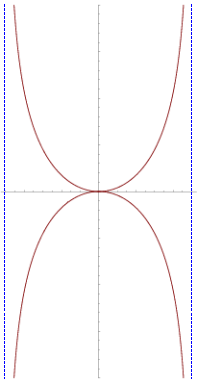Top Qs
Timeline
Chat
Perspective
Kappa curve
From Wikipedia, the free encyclopedia
Remove ads
Remove ads
In geometry, the kappa curve or Gutschoven's curve is a two-dimensional algebraic curve resembling the Greek letter ϰ (kappa). The kappa curve was first studied by Gérard van Gutschoven around 1662. In the history of mathematics, it is remembered as one of the first examples of Isaac Barrow's application of rudimentary calculus methods to determine the tangent of a curve. Isaac Newton and Johann Bernoulli continued the studies of this curve subsequently.

Using the Cartesian coordinate system it can be expressed as
or, using parametric equations,
In polar coordinates its equation is even simpler:
It has two vertical asymptotes at x = ±a, shown as dashed blue lines in the figure at right.
The kappa curve's curvature:
Tangential angle:
Remove ads
Tangents via infinitesimals
Summarize
Perspective
The tangent lines of the kappa curve can also be determined geometrically using differentials and the elementary rules of infinitesimal arithmetic. Suppose x and y are variables, while a is taken to be a constant. From the definition of the kappa curve,
Now, an infinitesimal change in our location must also change the value of the left hand side, so
Distributing the differential and applying appropriate rules,
Remove ads
Derivative
Summarize
Perspective
If we use the modern concept of a functional relationship y(x) and apply implicit differentiation, the slope of a tangent line to the kappa curve at a point (x,y) is:
Remove ads
References
- Lawrence, J. Dennis (1972). A Catalog of Special Plane Curves. New York: Dover. pp. 139–141. ISBN 0-486-60288-5.
External links
Wikiwand - on
Seamless Wikipedia browsing. On steroids.
Remove ads








\left(x^{2}+y^{2}\right)+x^{2}(2x\,dx+2y\,dy)-a^{2}2y\,dy&=0\\[6px]\left(4x^{3}+2xy^{2}\right)dx+\left(2yx^{2}-2a^{2}y\right)dy&=0\\[6px]x\left(2x^{2}+y^{2}\right)dx+y\left(x^{2}-a^{2}\right)dy&=0\\[6px]{\frac {x\left(2x^{2}+y^{2}\right)}{y\left(a^{2}-x^{2}\right)}}&={\frac {dy}{dx}}\end{aligned}}}](http://wikimedia.org/api/rest_v1/media/math/render/svg/e2fbbee06e516acb095da379a192f66d2c38e956)
![{\displaystyle {\begin{aligned}2x\left(x^{2}+y^{2}\right)+x^{2}\left(2x+2y{\frac {dy}{dx}}\right)&=2a^{2}y{\frac {dy}{dx}}\\[6px]2x^{3}+2xy^{2}+2x^{3}&=2a^{2}y{\frac {dy}{dx}}-2x^{2}y{\frac {dy}{dx}}\\[6px]4x^{3}+2xy^{2}&=\left(2a^{2}y-2x^{2}y\right){\frac {dy}{dx}}\\[6px]{\frac {2x^{3}+xy^{2}}{a^{2}y-x^{2}y}}&={\frac {dy}{dx}}\end{aligned}}}](http://wikimedia.org/api/rest_v1/media/math/render/svg/ba914f68cdf1eee7a64e63203b830e54b63a6522)